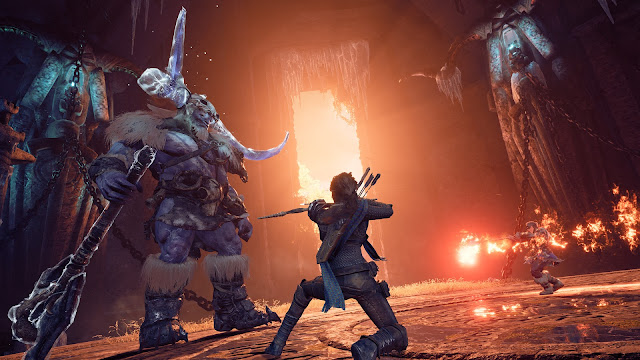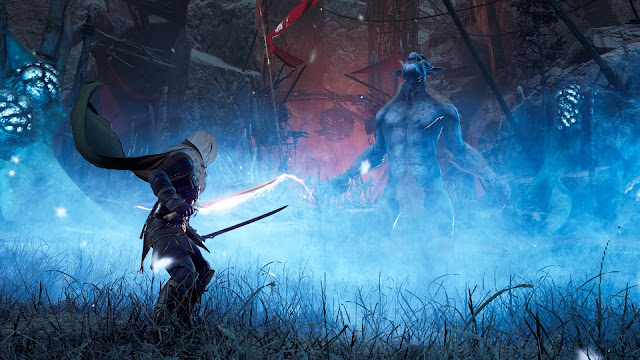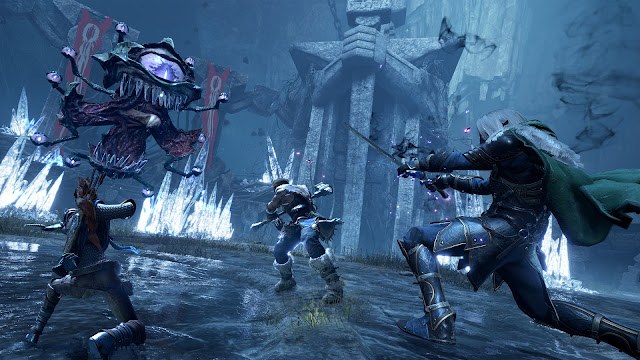Review by Matt S.
With over 30 books in print starring Drizzt Do’Urden and his companions, you would think that there’s plenty of material to turn into a compelling RPG. After all, while R.A Salvatore’s novels are pulp fantasy in every sense of the term, so too are The Witcher novels, and look at what CD Projekt Red achieved with a fraction of the source material. Dungeons & Dragons: Dark Alliance, unfortunately, misses the mark on Drizzt Do’Urden on every level. Even if you were able to put aside the game’s many, many gameplay issues, the mistreatment of the property is unforgivable.
I’ve already addressed the issues with the use of the license in a video, so I’m not going to re-tread them in this review. There’s more than enough to talk about with regards to the gameplay instead, which is bland and generic at the best of times, and downright broken for the most part. The biggest issue is the AI, especially when you use Catti-brie, the ranged-focused archer character of the four heroes you can choose between. It was embarrassingly easy to stand at the edge of a room, within bow range of enemies but outside of their detection range, and fire away without consequence. I’m not exaggerating; the enemies would stand around, totally unresponsive, until they’d run out of health and just fell over dead.
It’s not just the peons, either. I was able to defeat major enemies and mid-level bosses using this “trick”, completely undercutting any interest I might have developed in the combat. Now, by nature, the other three melee-focused characters must draw attention to fight the enemies, but even then the AI is just dismal. Enemies have a real love of turning their back to your character and, in multiplayer, randomly changing targets without actually bothering to attack anyone. I’ve not played a game with such utterly inept AI for as long as I can remember.
Another issue is that Dark Alliance is a multiplayer-focused game, but does very little of interest with that. In other words, all the mechanics are incredibly individualistic. Some character abilities do assist or mildly boost allies, but better multiplayer-focused games these days give each character skills that are only marginally useful by themselves, but powerful when applied in combination with another character’s abilities. There’s so little of that in Dark Alliance that, in most cases, multiplayer combat involved each player squaring off against their own little horde of enemies and battering them down before checking to see if there were any residuals hanging about.
I do get what the developers were aiming for, and in some instances, they almost got there. Rather than emulate a serious RPG (such as The Witcher), or even Diablo, which has a more seamless and connected world, the developers were instead trying to create a modern Gauntlet, giving players a series of self-contained levels with a heavy action focus, only swapping the top-down isometric perspective of Gauntlet for a more dramatic and modern behind-the-back look at the action. In the rare moment where the combat comes together you do get a feel for that vision, and Gauntlet itself wasn’t so much an exercise in teamwork as an “everyone button mashes together and has fun” experience. Unfortunately, clumsy, clunky, unnecessarily weighty attacks, and that woeful AI conspire to ensure that Dark Alliance very rarely “comes together” in the way that the manic, explosive action of Gauntlet does.
One small mercy is that the game does look nice. There are a number of three-stage “campaigns” to play through, and they run the gamut of underground lairs and ruins through to chilly, craggy mountains and tundras (the game is set in the permafrost Icewind Dale setting within D & D). Unfortunately, those levels are devoid of context. Like the heroes that the game supposedly depicts, Icewind Dale is an iconic location within D & D, but you never feel like you’re doing more than running through MMO-style dungeon locations. Furthermore, and really unfortunately, the character design is, visually, utterly bland. To an extent generic goblin, troll, and dead things monsters makes sense to a Dungeons & Dragons game, but my beloved Catti-brie is not an off-brand Aloy from Horizon, Bruenor is too wizened to be the generic dwarf presented here, and in the books, Wulfgar is meant to give Schwarzenegger’s Conan a run for his money (the dude literally pins a 12-foot Balor’s arm in one scene within the books… the monster derived from Lord of the Rings’ Balrog! Just imagine how built you would need to be to do that!). In the game, here, he’s just a dude. Sure he’s got some muscles and has a big hammer, but he ain’t that intimidating.
Further compounding this game’s struggle to have an identity, the level design isn’t interesting. At all. The main quest is an easily sign-posted linear path, and while there are “secret” areas with additional loot and, occasionally, some additional enemies to combat, they’re rarely far off the beaten track and it never really feels like you’re exploring as you’re playing. Secondary objectives are few and tend to be too dull to bother with, and when you do finish a level and are returned to the hub world, it itself is entirely devoid of anything interesting to do. There, you can level up, put on new equipment and upgrade existing loot, but that’s about it. All that’s left to do then is go grind some more. You never get to hang out with your characters, pop into the famous Ten Towns for a spot of shopping and inn-based socialising, or even undertake side quests. Perhaps all of this is a consequence of budgetary constraints, but when you break it down, there is almost nothing to do but delve into a limited number of pre-designed levels, fight the same enemies over and over again, and then do that same level again (although possibly at a higher level for even better loot).
To conclude my deep and unresolvable issues with this game – and make no bones about it, patching the AI isn’t going to make Dark Alliance a good game – I know I’ve covered the license in a video already, but Drizzt’s team don’t even make for a good Dungeons & Dragons party. Two of the four are considered stock-standard fighters in the Dungeons & Dragons ruleset, Drizzt himself is a ranger (a marginally different type of fighter), and Wulfgar is a barbarian (a much less subtle fighter). Part of the joy of Dungeons & Dragons is having that mix of character classes, with rogues, wizards, clerics, paladins, assassins, bards and warlocks joining the standard character types, to make each combat encounter dynamic and varied, and additionally open up stealth and even non-combat solutions to encounters. In Dark Alliance, the developers couldn’t even give us Regis. Of the five heroes in Drizzt’s crew, as a halfling rogue generally adverse to combat, he would have been the one opportunity to present a meaningfully different play style, but he’s not in the game at all.
For all of the above criticisms, there was one feature that I really liked and felt was a genuine Dungeons & Dragons moment; after major battles, a campfire would pop up, and you would have two options. You could take a “short rest” (a term cribbed from Dungeons & Dragons) to restore your health and potions, or you could choose to forge on without resting, resulting in fewer resources for the next encounter, but in exchange getting a better chance of loot drops being of higher (rarer) quality. That risk-reward system added a lot of quick decision-making, especially in multiplayer (because you only have around 30 seconds to decide how to use the campfire), and it did very much encourage players to err on the side of risk-taking. That could have made later battles in a dungeon so much more compelling. Of course, the risks were a little undermined by how easy it was to exploit the enemy AI in most cases…
Look. I had my reservations about this game. From the day it was announced, the way the developers were presenting the game made me think that they saw Drizzt and his pals as content to be exploited to flog copies off to fans, rather than beloved characters to interpret into a video game in a compelling way, unique to the stories that have been built around them. I was still keen to play it, though, hoping against hope, as a deep fan of both D & D and Drizzt.
– Matt S.
Editor-in-Chief
Find me on Twitter: @mattsainsb











